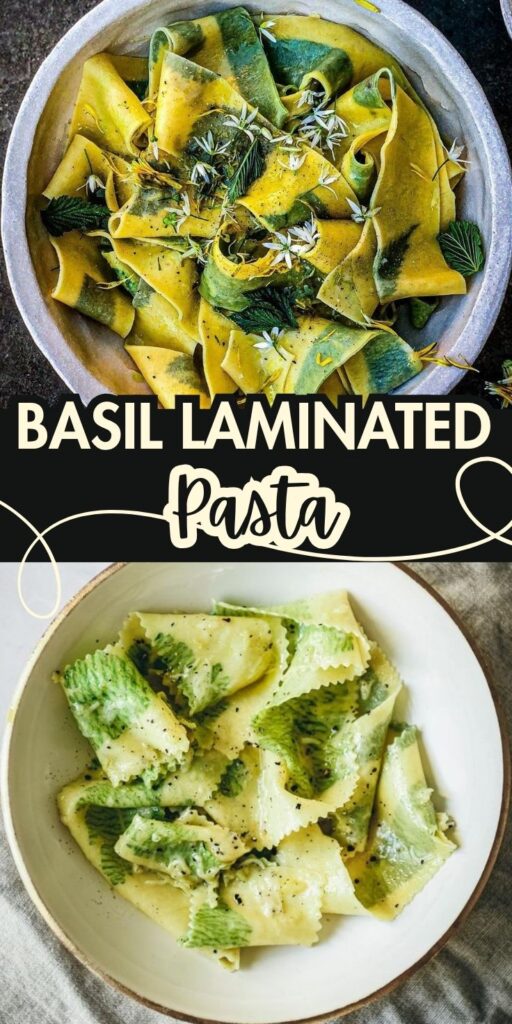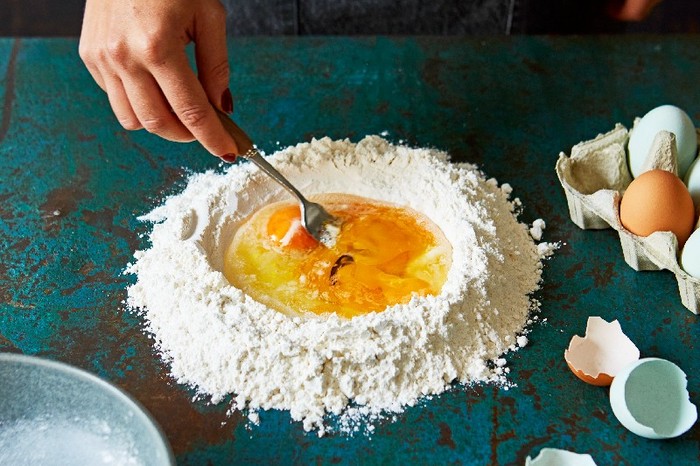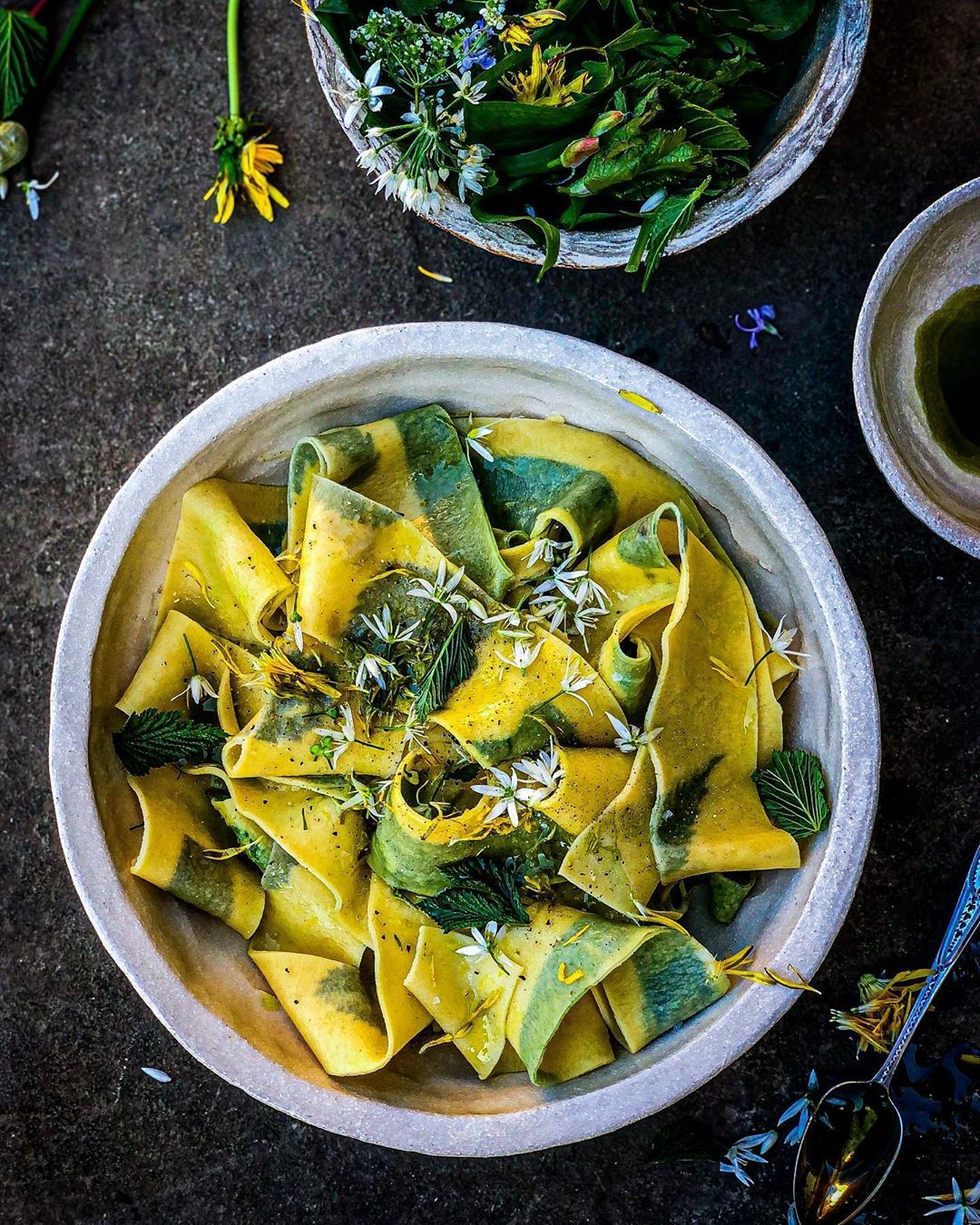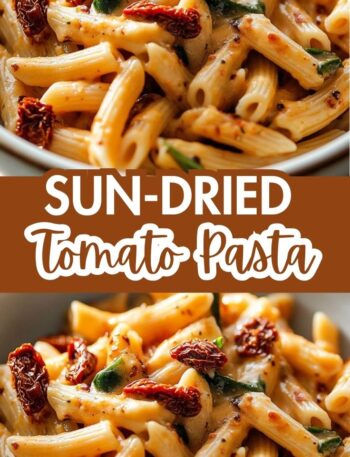
Basil Laminated Pasta is a visually striking and flavorful handmade pasta that features delicate basil leaves pressed between sheets of fresh pasta dough. This artisanal technique not only infuses the pasta with the herb’s aromatic essence but also creates a beautiful, lace-like pattern that makes each piece a work of art.
Often used for dishes like ravioli or tagliatelle, basil laminated pasta pairs wonderfully with light sauces, olive oil, or lemon butter to highlight its subtle herbal notes.
A celebration of craftsmanship and fresh ingredients, this pasta is perfect for special occasions or to elevate a simple Italian meal.
Basil laminated pasta is a stunning, flavorful twist on fresh handmade pasta. It features vibrant green basil leaves embedded between layers of golden pasta dough, creating a stained-glass effect.
Not only is it beautiful, but the basil also adds a fresh herbal note that pairs wonderfully with light sauces like lemon butter, garlic oil, or a simple cherry tomato reduction.
Laminated pasta is especially popular in upscale Italian and modern fusion kitchens, where visual appeal is as crucial as taste. It’s easier than it looks—if you can make basic pasta dough and roll it out, you can make this dish at home.
Basil Laminated Pasta
Description
Basil laminated pasta is a visually stunning and flavorful twist on traditional homemade pasta.
Fresh basil leaves are carefully layered and pressed between sheets of pasta dough, creating a beautiful green herb pattern throughout the golden surface.
This technique not only adds aromatic depth but also enhances the dish's presentation, making it ideal for elegant meals.
The pasta is typically rolled thin to showcase the basil design and pairs wonderfully with light sauces like lemon butter or garlic-infused olive oil.
Basil laminated pasta celebrates freshness, artistry, and craftsmanship—perfect for gourmet dining or impressing guests with a homemade Italian touch.
Ingredients
For Lamination:
Instructions
-
Make the Pasta Dough
-
Pour the flour onto a clean surface and make a well in the center.
-
Crack the eggs into the well. Add salt and olive oil.
-
Use a fork to whisk the eggs, gradually pulling in flour from the sides.
-
Once a shaggy dough forms, use your hands to knead it together.
-
Knead for 8–10 minutes until the dough is smooth and elastic. Add a sprinkle of flour if it’s sticky, or a few drops of water if it’s dry.
-
Wrap the dough in plastic wrap and let it rest at room temperature for at least 30 minutes.
Tip: Resting allows the gluten to relax, making the dough easier to roll.
-
-
Prepare the Basil Leaves
-
Rinse and pat dry the basil leaves completely.
-
Pick leaves similar in size and shape for even layering.
-
Set them aside on a dry towel until ready to laminate.
-
-
Roll Out the Pasta
-
Divide the rested dough into 2 equal pieces.
-
Flatten one piece with a rolling pin or your hands.
-
Roll it through a pasta machine, starting at the widest setting. Repeat and decrease the thickness gradually until it reaches about 1 mm or setting #5–6 on your machine.
-
Place the sheet on a floured surface or parchment paper.
-
Repeat the same process with the second piece of dough.
-
-
Laminate with Basil
-
Lay one pasta sheet flat. Lightly mist or brush with water (this helps seal the layers).
-
Arrange basil leaves across the sheet, leaving small gaps between them. Press lightly to help them stick.
-
Carefully place the second pasta sheet on top, aligning edges.
-
Press around each basil leaf to remove air bubbles.
-
Run the laminated sheet through the pasta machine again (start on a slightly wider setting to avoid tearing, then reduce gradually). This seals the basil inside and stretches the pasta.
Tip: Don’t start on the thinnest setting—laminated pasta is more delicate and can tear easily.
-
-
Cut and Shape
-
Use a sharp knife, pasta wheel, or cutter to shape the pasta as desired:
-
Fettuccine or pappardelle: Long ribbons for butter or oil-based sauces
-
Ravioli: To show off the basil inside each pillow
-
Lasagna sheets: For visual impact in layered dishes
-
Dust the cut pasta lightly with flour to prevent sticking.
-
-
Cook the Pasta
-
Bring a large pot of salted water to a boil.
-
Cook the pasta for 2–4 minutes, depending on thickness.
-
Fresh pasta cooks quickly—taste test to ensure it’s al dente.
-
Nutrition Facts
Servings 4
- Amount Per Serving
- Calories 270kcal
- % Daily Value *
- Total Fat 5g8%
- Saturated Fat 1.5g8%
- Sodium 50mg3%
- Total Carbohydrate 46g16%
- Dietary Fiber 3g12%
- Sugars 2g
- Protein 10g20%
* Percent Daily Values are based on a 2,000 calorie diet. Your daily value may be higher or lower depending on your calorie needs.
Note
Basil laminated pasta is not just a treat for the palate—it’s a visual masterpiece. With vibrant green basil leaves pressed between delicate sheets of fresh pasta, it adds elegance and flavor to any dish.
Making and serving this pasta is an art form in itself. Here's a complete guide on how to perfect, serve, store, and customize basil laminated pasta.
Tips for Perfect Basil Laminated Pasta
- Use Fresh Herbs:
Choose young, flat basil leaves without blemishes. Fresh herbs not only look better when laminated but also release more aroma and flavor during cooking. - Roll Evenly:
For best results, roll out your pasta dough thinly before laminating the basil. Lay the leaves evenly over one sheet and cover it with another, then roll again to press and seal the herbs. A pasta machine helps maintain uniform thickness. - Dust with Semolina:
Dust both sides of the dough lightly with semolina before laminating to prevent sticking when rolling through the machine again. - Hydration is Key:
Pasta dough should be soft but not sticky. If it’s too dry, the leaves won’t adhere properly; too wet, and the dough will tear. - Press Gently but Firmly:
After layering basil leaves, use a rolling pin or pasta machine to gently press the layers together. Avoid tearing the dough—especially near the leaves.
Serving Tricks
- Simple Sauces Work Best:
Highlight the beauty and taste of basil laminated pasta with light sauces—think brown butter and sage, garlic olive oil, or a lemon cream sauce. Avoid heavy red sauces that may overpower or hide the basil. - Cut it Creatively:
Use a pasta wheel or sharp knife to cut the dough into elegant ribbons like fettuccine or pappardelle. Wide cuts showcase the herb design better than thin noodles. - Finish with Freshness:
Garnish with fresh basil, lemon zest, grated Parmesan, or a drizzle of truffle oil. These accents enhance both the look and flavor. - Perfect Pairings:
Pair with grilled vegetables, seafood (like scallops or shrimp), or roasted chicken for a restaurant-quality plate.
Storage Instructions
- Short-Term (Refrigerator):
Store fresh laminated pasta in a single layer on a parchment-lined tray, covered loosely with plastic wrap. Refrigerate for up to 1 day. Dust with flour to avoid sticking. - Long-Term (Freezing):
Freeze uncooked pasta in nests or flat sheets on a tray. Once frozen, transfer to airtight containers or ziplock bags. Keeps well for up to 2 months. Cook directly from frozen—no need to thaw. - Cooked Pasta:
Store cooked basil pasta tossed in a bit of olive oil in the fridge for up to 2 days. Reheat gently in a pan with a splash of water or sauce.
Variations
- Other Herbs:
Try parsley, chervil, sage, or tarragon for different flavors and aesthetics. You can even mix herbs for a multi-color effect. - Edible Flowers:
Nasturtiums, pansies, or marigold petals can be laminated alongside basil for a stunning floral pasta ideal for spring dishes. - Flavored Doughs:
Color the dough itself using spinach puree (green), roasted red pepper (red), or squid ink (black). Laminate herbs onto contrasting doughs for visual impact. - Stuffed Pasta:
Turn laminated sheets into ravioli or tortellini with fillings like ricotta and lemon zest, roasted garlic mushrooms, or herbed goat cheese. - Whole Wheat or Gluten-Free:
Though trickier, these versions are possible with careful hydration and handling. Ensure dough is elastic enough to stretch around herbs without cracking.
Suggested Serving Ideas
- Lemon garlic butter sauce with shaved parmesan
- Cherry tomatoes sautéed with olive oil and garlic, topped with burrata
- Brown butter and sage sauce
- Chilled with olive oil and roasted veggies for a summer pasta salad
Tips for Success
- Use dry leaves only. Moisture from wet basil can cause the sheets to separate.
- Work fast when laminating. The dough can dry out quickly; keep unused dough covered.
- Store with care. If not cooking immediately, store in the fridge on a floured tray covered with a towel for up to 1 day. For longer storage, freeze in nests.
Final Note:
Basil laminated pasta is more than just a meal—it’s an experience. Whether you serve it on a weeknight for family or at a dinner party to impress guests, its fresh flavors and elegant look will stand out. With the right preparation and creativity, it becomes a canvas for culinary artistry.
Frequently Asked Questions
What is basil laminated pasta?
Basil laminated pasta is a type of fresh homemade pasta where basil leaves are pressed between sheets of pasta dough before rolling it thin.
This creates a beautiful visual effect, with the basil leaves appearing like stained glass embedded within the pasta. It not only looks stunning but also adds a light herbal flavor to the dish.
Do I need a pasta machine to make it?
While a pasta machine helps achieve evenly thin and smooth sheets, it’s not strictly necessary. You can use a rolling pin, though it may take more effort to reach the desired thinness.
The key is to roll the first pasta sheet thin, place basil leaves over it, cover with another sheet, and then roll them together to fuse.
Will the basil leaves affect the texture or cooking time?
Not significantly. The leaves are thin and become part of the dough once laminated. Cooking time remains similar to regular fresh pasta—usually around 2–3 minutes in boiling salted water. However, overcooking may dull the vibrant green appearance of the basil, so it’s best to cook it gently and briefly.
What sauces pair best with basil laminated pasta?
Because basil already adds a fresh, fragrant note, it’s best paired with light sauces. Think olive oil, lemon butter, pesto, or simple cream sauces. Heavy red sauces might overpower its delicate flavor and visual charm. It also pairs wonderfully with fresh vegetables, seafood, or lightly sautéed garlic and herbs.








